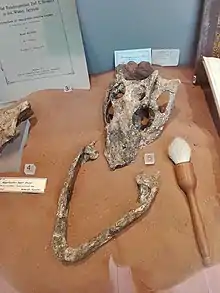| Libycosuchus Temporal range: Late Cretaceous, | |
|---|---|
 | |
| Skull and jaw | |
| Scientific classification | |
| Kingdom: | |
| Phylum: | |
| Class: | |
| (unranked): | |
| Suborder: | |
| Family: | †Libycosuchidae Stromer, 1933 |
| Subfamily: | †Libycosuchinae Nopsca, 1928 |
| Genus: | †Libycosuchus Stromer, 1914 |
| Binomial name | |
| †Libycosuchus brevirostris Stromer, 1914 | |
| Synonyms | |
| |
Libycosuchus is an extinct genus of North African crocodylomorph possibly related to Notosuchus;[1][2] it is part of the monotypic Libycosuchidae[3] and Libycosuchinae.[4] It was terrestrial, living approximately 95 million years ago in the Cenomanian stage of the Late Cretaceous. Fossil remains have been found in the Bahariya Formation in Egypt,[5] making it contemporaneous with the crocodilian Stomatosuchus, and dinosaurs, including Spinosaurus.[1] It was one of the few fossils discovered by Ernst Stromer that wasn't destroyed by the Royal Air Force during the bombing of Munich in 1944.[6] The type species, L. brevirostis, was named in 1914[7] and described in 1915.[5]
References
- 1 2 Buffetaut, E. 1982. Radiation évolutive, paléoécologie et biogéographie des Crocodiliens mésosuchienes. Mémoires Societé Geologique de France 142: 1–88.
- ↑ P. M. Nascimento and H. Zaher. 2011. The skull of the Upper Cretaceous baurusuchid crocodile Baurusuchus alberoi Nascimento & Zaher 2010, and its phylogenetic affinities. Zoological Journal of the Linnean Society 163:S116-S131
- ↑ E. Stromer. 1933. Ergebnisse der Forschungsreisen Prof. E. Stromers in den Wüsten Ägyptens. II. Wirbeltierreste der Baharîje-Stufe (unterstes Cenoman). 12. Die procölen Crocodilia. [Results of the expeditions of Professor E. Stromer in the Egyptian deserts. II. Vertebrate animal remains from the Baharîje bed (lowest Cenomanian). 12. The procoelous Crocodilia.]. Abhandlungen der Bayerischen Akademie der Wissenschaften Mathematisch-naturwissenschaftliche Abteilung, Neue Folge 15:1-31
- ↑ B. F. Nopcsa. 1928. The genera of reptiles. Palaeobiologica 1:163-188
- 1 2 Original citation: Stromer, E. 1915. Ergebnisse der Forschungsreisen Prof. E. Stromers in den Wüsten Ägyptens. II. Wirbeltier-Reste der Baharîje-Stufe (unterstes Cenoman). 3. Das Original des Theropoden Spinosaurus aegyptiacus nov. gen., nov. spec. Abhandlungen der Königlichen Bayerischen Akademie der Wissenschaften, Mathematisch-physikalische Klasse 28(3):1-32.
- ↑ Tumarkin-Deratzian, Allison; Grandstaff, Barbara S.; Lamanna, Matthew; Smith, Joshua B. (September 2004). "New material of Libycosuchus brevirostris from the Cenomanian Bahariya Formation of Egypt". Journal of Vertebrate Paleontology. 24 (3): 123A. Retrieved 3 November 2020.
- ↑ Stromer 1914, p. 28 and 29, fn. 1
This article is issued from Wikipedia. The text is licensed under Creative Commons - Attribution - Sharealike. Additional terms may apply for the media files.
